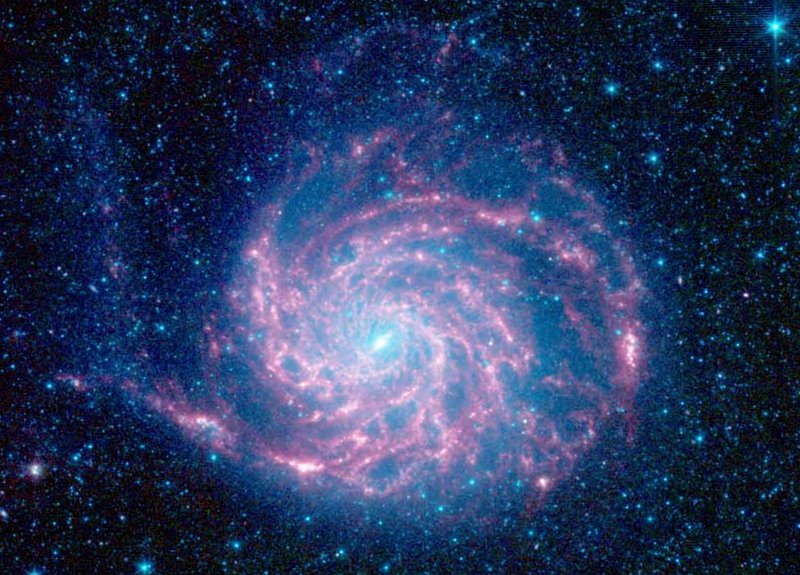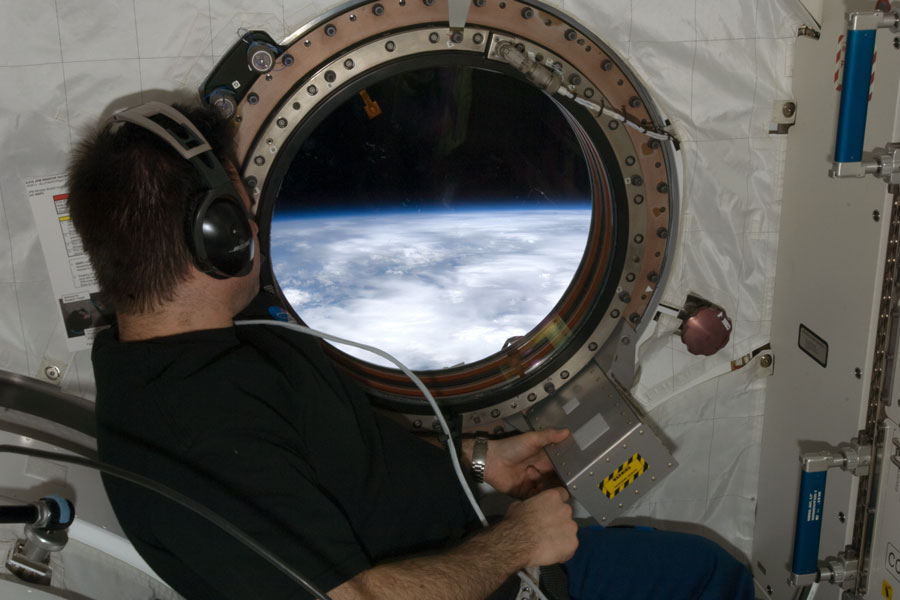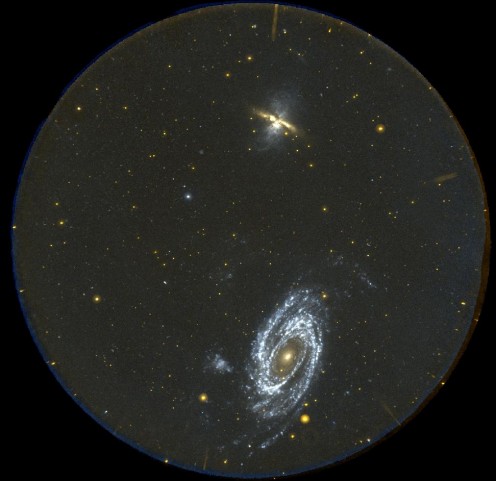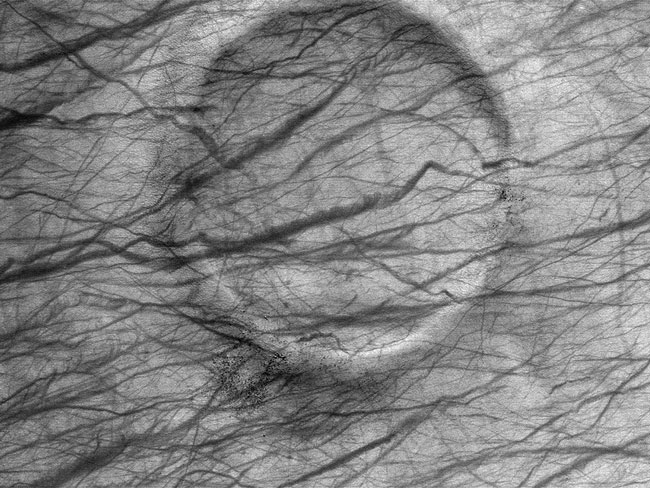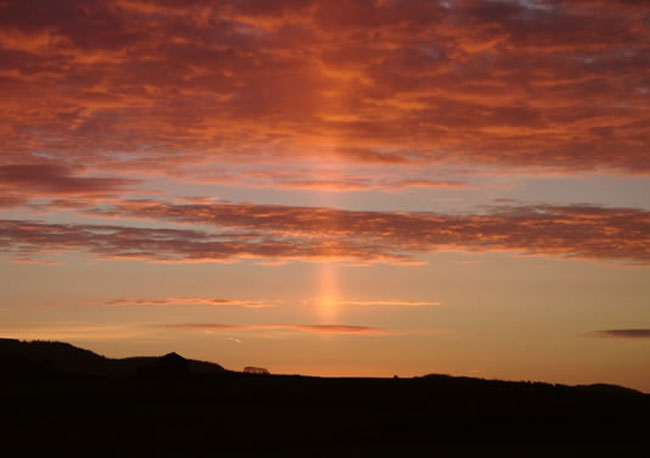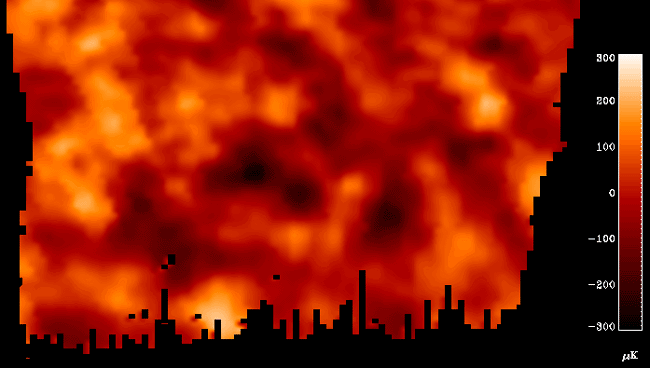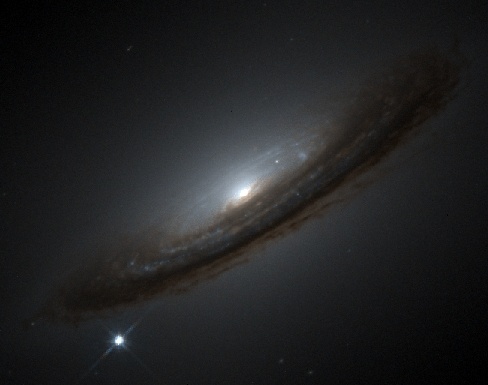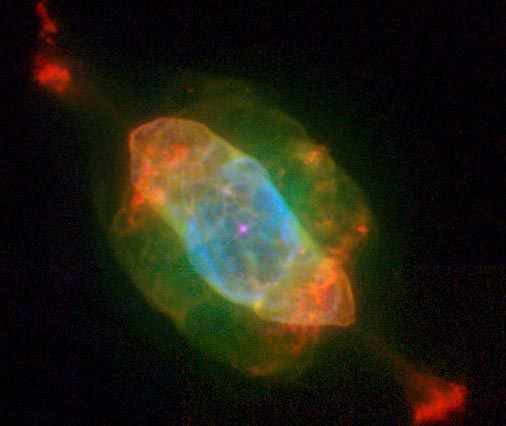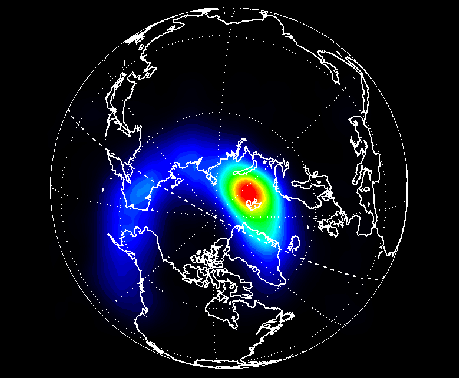| << Previous | Index | Next >> |
2014 The awesomeness in this image comes in layers. The closest layer, in the foreground, contains the Peak Terskol Observatory located in the northern Caucasus Mountains of Russia. The white dome over the 2-meter telescope is clearly visible. The observatory is located on a shoulder of Mt. Elbrus, the highest mountain in Europe, with other peaks visible in a nearby background layer. Clouds are visible both in front of and behind the mountain peaks. The featured three-image composite panorama was taken in 2014 August. Far in the distance is the most distant layer: the stars and nebulas of the night sky, with the central band of the Milky Way rising on the image right.
2013 What strange world is this? Pictured above is no real place but rather a purely mathematical visualization of a generalization of a fractal into three dimensions. Classical fractal diagrams are typically confined to the two dimensions inherent in the complex number plane, demarking regions where an iterative function diverges. Recently explored additions expand the Mandelbrot set of fractals to three dimensions with prescriptions dubbed Mandelbox and Mandelbulb sets. The results are often visually stunning creations of virtual worlds with limitless detail, some of which you can fly through. Pictured above is one such mathematical fantasy, possibly reminiscent of some sort of steam-punkian, quantum-mechanical landscape.
2012 Eta Carinae may be about to explode. But no one knows when - it may be next year, it may be one million years from now. Eta Carinae's mass - about 100 times greater than our Sun - makes it an excellent candidate for a full blown supernova. Historical records do show that about 150 years ago Eta Carinae underwent an unusual outburst that made it one of the brightest stars in the southern sky. Eta Carinae, in the Keyhole Nebula, is the only star currently thought to emit natural LASER light. This image, taken in 1996, brought out new details in the unusual nebula that surrounds this rogue star. Now clearly visible are two distinct lobes, a hot central region, and strange radial streaks. The lobes are filled with lanes of gas and dust which absorb the blue and ultraviolet light emitted near the center. The streaks remain unexplained.
2011 The monster at the center of our Galaxy is about to get fed. Recent observations by the Very Large Telescopes indicate that a cloud of gas will venture too close to the supermassive black hole at the Galactic center. The gas cloud is being disrupted, stretched out, heated up, and some of it is expected to fall into the black hole over the next two years. In this artist's illustration, what remains of the blob after a close pass to the black hole is shown in red and yellow, arching out from the gravitational death trap to its right. The cloud's orbit is shown in red, while the orbits of central stars are shown in blue. The infalling nebula is estimated to contain several times the mass of our Earth, while the central black hole, thought to correspond to the radio source Sagittarius A*, contains about four million times the mass of our Sun. Once it falls in, nothing is expected to be heard from the doomed gas ever again.
2010 In this beautiful celestial still life composed with a cosmic brush, dusty nebula NGC 2170 shines at the upper left. Reflecting the light of nearby hot stars, NGC 2170 is joined by other bluish reflection nebulae, a compact red emission region, and streamers of obscuring dust against a backdrop of stars. Like the common household items still life painters often choose for their subjects, the clouds of gas, dust, and hot stars pictured here are also commonly found in this setting - a massive, star-forming molecular cloud in the constellation Monoceros. The giant molecular cloud, Mon R2, is impressively close, estimated to be only 2,400 light-years or so away. At that distance, this canvas would be about 15 light-years across.
2009 Big, beautiful spiral galaxy M101 is one of the last entries in Charles Messier's famous catalog, but definitely not one of the least. About 170,000 light-years across, this galaxy is enormous, almost twice the size of our own Milky Way Galaxy. M101 was also one of the original spiral nebulae observed by Lord Rosse's large 19th century telescope, the Leviathan of Parsontown. Recorded at infrared wavelengths by the Spitzer Space telescope, this 21st century view shows starlight in blue hues while the galaxy's dust clouds are in red. Examining the dust features in the outer rim of the galaxy, astronomers have found that organic molecules present throughout the rest of M101 are lacking. The organic molecules tracked by Spitzer's instruments are called polycyclic aromatic hydrocarbons (PAHs). Of course, PAHs are common components of dust in the Milky Way and on planet Earth are found in soot. PAHs are likely destroyed near the outer edges of M101 by energetic radiation in intense star forming regions. Also known as the Pinwheel Galaxy, M101 lies within the boundaries of the northern constellation Ursa Major, about 25 million light-years away.
2008 There's no place like home. Peering out of the window of the International Space Station (ISS), astronaut Greg Chamitoff takes in the planet on which we were all born. About 350 kilometers up, the ISS is high enough so that the Earth's horizon appears clearly curved. Astronaut Chamitoff's window shows some of Earth's complex clouds, in white, and life giving atmosphere and oceans, in blue. The space station orbits the Earth about once every 90 minutes. It is not difficult for people living below to look back toward the ISS. The ISS can frequently be seen as a bright point of light drifting overhead just after sunset. Telescopes can even resolve the overall structure of the space station. The above image was taken early last month from the ISS's Kibo laboratory.
2007 Normal cloud bottoms are flat because moist warm air that rises and cools will condense into water droplets at a very specific temperature, which usually corresponds to a very specific height. After water droplets form that air becomes an opaque cloud. Under some conditions, however, cloud pockets can develop that contain large droplets of water or ice that fall into clear air as they evaporate. Such pockets may occur in turbulent air near a thunderstorm, being seen near the top of an anvil cloud, for example. Resulting mammatus clouds can appear especially dramatic if sunlit from the side. These mammatus clouds were photographed over Monclova, Mexico.
2006 On planet Earth, an analemma is the figure-8 loop you get when you mark the position of the Sun at the same time each day throughout the year. But similarly marking the position of the Sun in the Martian sky would produce the simpler, stretched pear shape in this digital illustration, based on the Mars Pathfinder project's famous Presidential Panorama view from the surface. The simulation shows the late afternoon Sun that would have been seen from the Sagan Memorial Station once every 30 Martian days (sols) beginning on Pathfinder's Sol 24 (July 29, 1997). Slightly less bright, the simulated Sun is only about two thirds the size as seen from Earth, while the Martian dust, responsible for the reddish sky of Mars, also scatters some blue light around the solar disk.
2005 Here is one of the largest objects that anyone will ever see on the sky. Each of these fuzzy blobs is a galaxy, together making up the Perseus Cluster, one of the closest clusters of galaxies. The cluster is seen through a foreground of faint stars in our own Milky Way Galaxy. Near the cluster center, roughly 250 million light-years away, is the cluster's dominant galaxy NGC 1275, seen here just left of picture center. A prodigious source of x-rays and radio emission, NGC 1275 accretes matter as gas and galaxies fall into it. The Perseus Cluster of Galaxies is part of the Pisces-Perseus supercluster spanning over 15 degrees and containing over 1,000 galaxies. At the distance of NGC 1275, this view covers about 1.5 million light-years.
2004 Intriguing galaxy pair M81 and M82 shine in this full-field view from the orbiting GALEX observatory. GALEX - the Galaxy Evolution Explorer - scans the cosmos in ultraviolet light, a view that follows star formation and galaxy evolution through the Universe. Near the bottom, magnificent spiral galaxy M81, similar in size to our own Milky Way, shows off young stars in winding spiral arms. Less than 100 million years old, the young stars are blue in the false-color GALEX image and seen to be well separated from the older yellowish stars of the galactic core. But near the top, turbulent, irregular galaxy M82 shows the results of extreme rates of star birth and death. Supernovae, the death explosions of massive stars, contribute to a violent wind of material expelled from M82's central regions. The striking irregular and spiral galaxy pair are located only about 10 million light-years away in the northern constellation Ursa Major.
2003 What caused the streaks in this Martian crater? Since the above image shows streaks occurring both inside and outside the crater, they were surely created after the crater-causing impact. Newly formed trails like these presented researchers with a tantalizing martian mystery but have now been identified as likely the work of miniature wind vortices known to occur on the red planet - martian dust devils. Another example of wind processes on an active Mars, dust devils had been detected passing near the Viking and Mars Pathfinder landers. Such spinning columns of rising air heated by the warm surface are common in dry and desert areas on planet Earth. Typically lasting only a few minutes, they becoming visible as they pick up loose dust. On Mars, dust devils can be up to 8 kilometers high and leave dark trails as they disturb the bright, reflective surface dust.
2002 Have you ever seen a sun pillar? When the air is cold and the Sun is rising or setting, falling ice crystals can reflect sunlight and create an unusual column of light. Ice sometimes forms flat, stop-sign shaped crystals as it falls from high-level clouds. Air resistance causes these crystals to lie nearly flat much of the time as they flutter to the ground. Sunlight reflects off crystals that are properly aligned, creating the sun-pillar effect. In the above picture, a sun-pillar reflects light from a setting Sun.
2001 Dust pillars are like interstellar mountains. They survive because they are more dense than their surroundings, but they are being slowly eroded away by a hostile environment. Visible in the above picture is the end of a huge gas and dust pillar in the Trifid Nebula, punctuated by a smaller pillar pointing up and an unusual jet pointing to the left. The pink dots are newly formed low-mass stars. A star near the small pillar's end is slowly being stripped of its accreting gas by radiation from a tremendously brighter star situated off the above picture to the upper right. The jet extends nearly a light-year and would not be visible without external illumination. As gas and dust evaporate from the pillars, the hidden stellar source of this jet will likely be uncovered, possibly over the next 20,000 years.
2000 No matter which direction you look, no matter what type of light you see, the sky glows - but why? The sources of many of these background radiations have remained long-standing puzzles, but this millennial year brought some partial resolutions. In X-ray light the recently launched spacecraft Chandra and XMM resolved much of the seemingly uniform X-ray background into many discrete sources, many of which appear to be black holes at the centers of galaxies accreting matter. In microwave light, the BOOMERANG and MAXIMA-1 missions resolved with new clarity the seemingly uniform microwave background. The size and distribution of these spots indicates a geometrically flat universe, which, when combined recent supernovae results, indicate a universe with an accelerating expansion rate filled with dark matter and dark energy. Pictured above, a map spanning ten degrees of the microwave sky resolves the microwave background into hot and cold spots, as indicated in microkelvins.
1999 As the twentieth century dawned a debate raged over whether the Milky Way was the entire universe. The 1920s brought observations of spiral-nebulae that housed familiar but faint variable stars, and hence placed these nebulae much farther than anything else ever found. The Milky Way, apparently, is itself a spiral nebula seen from the inside. Soon interstellar dust was identified as the opaque material that blocks our view of distant spiral arms, confirming that our Sun was well away from the center. As the twentieth century closes, galaxies are seen forming across the universe, and our Milky Way is referred to as a spiral galaxy quite similar to NGC 1288, as pictured above.
1998 Far away, long ago, a star exploded. Supernova 1994D, visible as the bright spot on the lower left, occurred in the outskirts of disk galaxy NGC 4526. Supernova 1994D was not of interest for how different it was, but rather for how similar it was to other supernovae. In fact, the light emitted during the weeks after its explosion caused it to be given the familiar designation of a Type Ia supernova. If all Type 1a supernovae have the same intrinsic brightness, then the dimmer a supernova appears, the farther away it must be. By calibrating a precise brightness-distance relation, astronomers are able to estimate not only the expansion rate of the universe (parameterized by the Hubble Constant), but also the geometry of the universe we live in (parameterized by Omega and Lambda). The large number and great distances to supernovae measured in 1998 have been interpreted as indicating that we live in a previously unexpected universe.
1997 The layers of the Saturn Nebula give a complex picture of how this planetary nebula was created. The above picture, taken in April 1996 and released last week, allows a better understanding of the mysterious process that transformed a low-mass star into a white dwarf star. A computer model indicates that the central star of NGC 7009 first expelled the green gas that now appears barrel shaped. This green gas now confines stellar winds flowing from the central star, creating a jet which forms the ansae that appear in red at the tips. Much remains unknown, including why the gas has not become turbulent.
1996 The Earth glows in many kinds of light, including the energetic X-ray band. Actually, the Earth itself does not glow - only aurora produced high in the Earth's atmosphere. Above is the first picture of the Earth in X-rays, taken in March with the orbiting Polar satellite. Bright X-ray emission is shown in red. Energetic ions from the Sun cause aurora and energize electrons in the Earth's magnetosphere. These electrons move along the Earth's magnetic field and eventually strike the Earth's ionosphere, causing the X-ray emission. These X-rays are not dangerous because they are absorbed by lower parts of the Earth's atmosphere.
1995 The strongest source of X-rays in the Large Magellanic Cloud originates from an unusually energetic binary star system. This strong source, dubbed LMC X-1, is thought to be a normal and compact star orbiting each other. Gas stripped of the normal star falls onto the compact star, heats up, and emits X-rays. The X-rays shining from the system knock electrons off atoms for light years around, causing some atoms to glow noticeably in X-rays when the electrons re-combine. Motion in the binary system indicates the compact star is probably a black hole, since its high mass - roughly five times that of our Sun - should be enough to cause even a neutron star to implode.
| << Previous | Index | Next >> |





